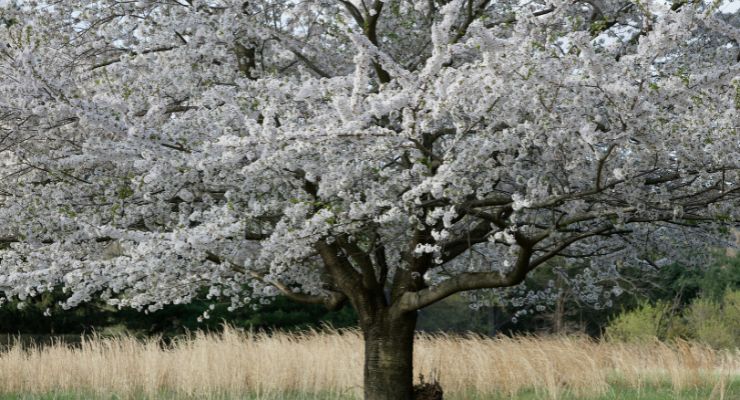White flowering trees are a beautiful and versatile addition to any landscape, providing stunning visual appeal and fragrance. The white color of their blossoms is associated with purity, innocence, and elegance, making them a popular choice for creating an enchanting and serene outdoor environment. They are often used to add contrast and depth to garden designs.
In addition to their aesthetic appeal, white flowering trees can also provide a range of practical benefits. They can offer shade and shelter for outdoor living spaces, provide privacy, and attract beneficial wildlife such as bees, butterflies, and birds. Some species of white flowering trees can also produce edible fruits, adding an additional functional aspect to their beauty.
There are many different types of white flowering trees, each with its unique features and characteristics. Some bloom in spring, while others bloom in summer and fall. Some are small and compact, making them perfect for container gardens or small spaces, while others can grow to be massive shade trees.
In this article, we’ll provide an overview of the most popular types of white flowering trees and their characteristics, helping you to choose the perfect tree for your landscape.
American elderberry (Sambucus canadensis)
The American elderberry (Sambucus canadensis) is a deciduous small tree that is recognized for its sizable clusters of yellowish white flowers and is alternatively referred to as common elderberry or black elderberry. With a maximum height and width of 12 and 10 feet, respectively, this fast-growing species is ideal for use as a border plant.
When planting American elderberry, it is recommended to choose medium to wet, well-drained soil and a location with full sun to partial shade. Although the plant can tolerate various soil types, it prefers moist and humus-rich soil.
Since the plant has shallow roots, it is crucial to keep it sufficiently watered during the first year. As the plant spreads through root suckers to form colonies, it’s necessary to prune them unless you want to naturalize the area.
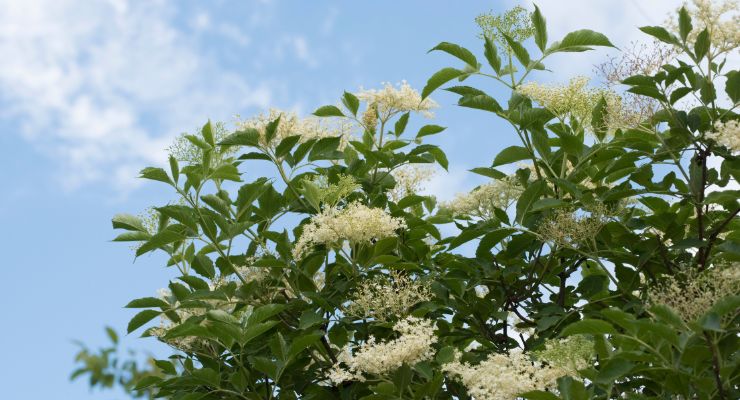
‘Donald Wyman’ Crabapple (Malus ‘Donald Wyman’)
A beautiful tree is known for its glossy green foliage and fragrant white flowers. ‘Donald Wyman’ crabapple is a large, spreading broad-leaved tree. It can grow up to 15-20 feet tall and slightly wider at maturity. This variety of crabapple is highly valued and is known for producing red fruit, which is considered a true treasure of this stunning tree.
The white flowering crabapple trees can be planted in soil that is workable throughout most of the year. While bare-root trees should be planted in early spring, balled and burlapped or container-grown trees can be planted from spring through fall. These trees require at least 6 hours of daily sun exposure and prefer rich, moist, and well-drained soils.
It’s important to water them regularly during their first year of growth, keeping the soil evenly moist over the root zone, approximately an inch per week.
These trees with white flowers require minimal pruning, with dead, diseased, and damaged twigs and branches removed in spring and suckers removed as they appear.
If you want some other trees with white flowers that bear fruits, you should consider for example a pear tree.
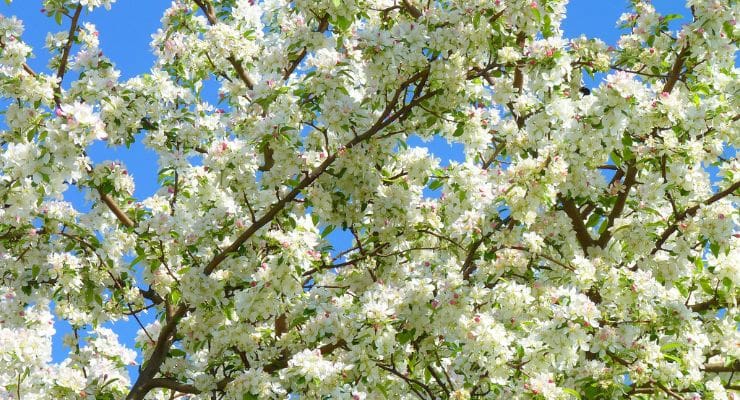
Serviceberry (Amelanchier canadensis)
The serviceberry, a small deciduous tree or shrub, is an attractive addition to any landscape due to its delicate white spring blossoms and year-round interest. Its leaves are also known to change color in the fall, making it one of the best small trees for fall foliage.
Serviceberry is a versatile plant that can be used as a specimen plant or a key plant in landscaping designs. It can also be pruned to resemble a small tree or allowed to grow as a large shrub with many branches
For optimal growth, Serviceberry trees require a minimum of four hours of direct sunlight per day and can tolerate partial shade. They also prefer moist, well-drained, and acidic soil but can adapt to a variety of soil types.
It is important to water young trees thoroughly and maintain soil moisture by mulching around the base of the tree with bark or wood chips.
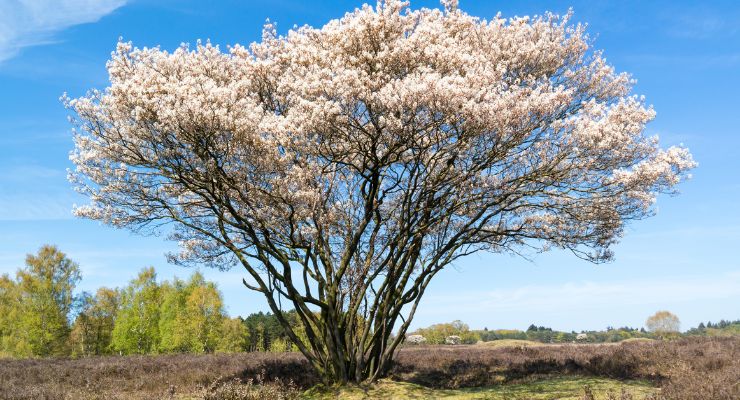
Angel’s trumpet (Brugmansia spp)
Angel’s trumpet, also known as datura, is a type of tropical small tree that is prized for its large, fragrant flowers that resemble trumpets. These beautiful flowers can come in a variety of colors, including white, yellow, and pink, and can add a touch of exotic beauty to any garden or landscape.
However, due to its tropical nature, Angel’s trumpet requires specific care such as pruning and fertilizing, and can only be grown in warm climates.
Angel’s trumpet is a poisonous plant containing toxic alkaloids such as atropine, scopolamine, and hyoscyamine. Ingestion of any part of the plant can cause severe symptoms such as hallucinations, seizures, and even death.
Symptoms of poisoning may include difficulty with speech and swallowing, vomiting, diarrhea, and intense thirst. It is important to keep the plant away from children and pets and to use caution when handling it.
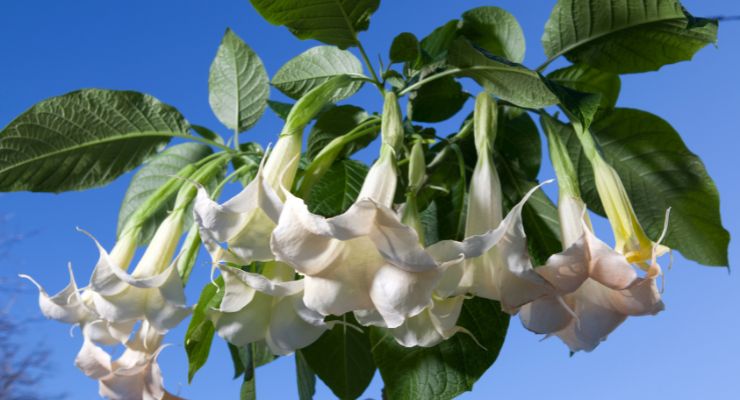
Orange Jasmine (Murraya paniculata)
Orange jasmine is a tropical to sub-tropical evergreen shrub or small tree. This plant is also referred to as orange jessamine, china box, or mock orange. The plant is characterized by its glossy, dark green leaves and lovely white flowers that have a sweet fragrance similar to that of orange blossoms. With its graceful pendulous branches, orange jasmine is an excellent choice for hedging and can grow up to 7 meters in height.
Orange jasmine is a drought-tolerant plant that can survive in dry conditions, but regular watering will help it thrive and produce frequent blooms. It is recommended to water deeply and infrequently rather than shallowly and frequently.
Apply a controlled-release fertilizer once a year, preferably in the spring, and top up the mulch to help retain moisture in the soil. Before laying the mulch, spread and lightly rake in some slow-release fertilizer to provide the plant with nutrients.
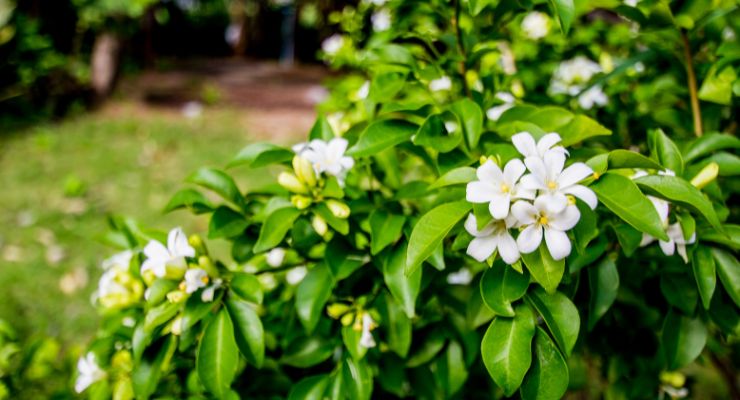
Japanese Snowbell (Styrax japonicus)
The Japanese Snowbell (Styrax japonicus) is a small tree with dark green foliage and a compact growth habit. Its bell shaped white flowers emit a light fragrance and typically bloom in May or early summer, adding to the tree’s charming appearance. The tree’s landscape appeal is enhanced by its interlacing orange-brown fissured bark.
For optimal growth, the tree requires well-draining, nutrient-rich, acidic soil, as well as full sun or partial shade, and protection from strong winds. Since the tree has horizontal branches, it should be planted where it has enough space to spread.
Consistently moist soil is necessary for the tree to thrive, but overwatering should be avoided. Use sharp pruning shears to trim the tree in late winter or early spring before new growth starts, to shape its growth according to your preferences.
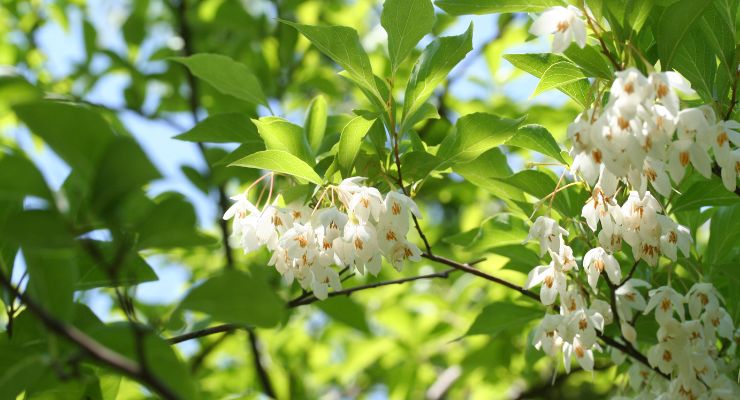
Bigleaf Magnolia (Magnolia Macrophylla)
Bigleaf magnolia is a striking deciduous tree that is native to the southeastern United States and eastern Mexico. It is known for its exceptional size, with leaves that can reach up to 30 inches long and white flowers that can be as wide as 14 inches.
The tree can grow up to 30-40 feet tall and is prized for its fragrant, creamy white flowers that bloom in early summer. Bigleaf magnolia is a rare and endangered species that are highly valued by horticulturists and plant enthusiasts.
Bigleaf magnolia is an ideal choice for use as a specimen or shade tree in parks or other large areas. This white flowering tree thrives in moist, organically rich, and well-drained loams with acidic or neutral ph. However, it is essential to plant tree away from urban pollutants, as it is highly sensitive to them.
The southern magnolia tree would be also a great choice, as it has white flowers too.
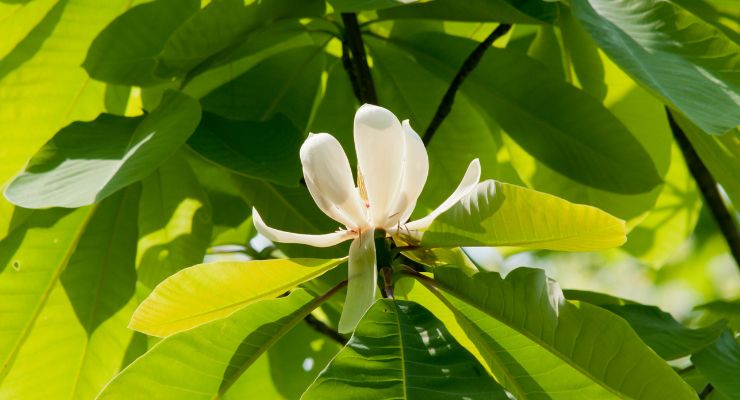
American Fringe Tree (Chionanthus virginicus)
The small deciduous American Fringe Tree is indigenous to the eastern part of the United States. The tree’s genus name is derived from the Greek words “chion,” which means snow, and “anthos,” which means flower.
It has glossy, dark-green foliage and produces beautiful clusters of creamy white, fragrant flowers with branching patterns that hang from its branches.
The fringe tree is versatile, making it a valuable addition to native woodland gardens, as a stand-alone specimen, in groups or borders, or near large buildings.
For optimal results, plant the fringe tree in partial shade to encourage better foliage or in full sun to stimulate more white flowers. To promote the growth of these trees with white flowers, it is recommended to provide them with rich, moist acidic soil and ample fertilizer.
While they typically grow at a slow rate of 6 to 10 inches per year, this can be accelerated to up to one foot per year with optimal growing conditions.
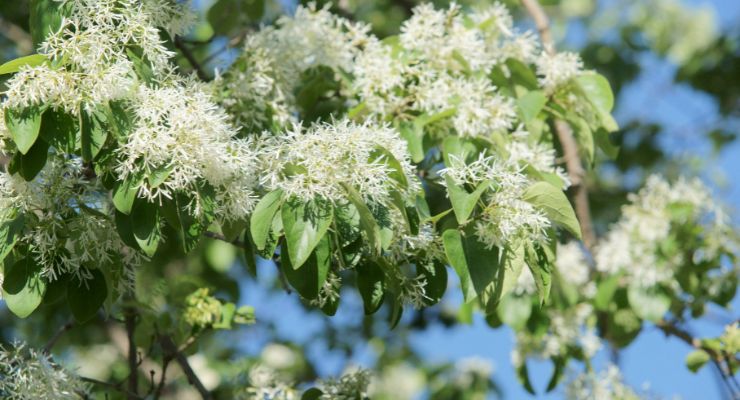
Yoshino Cherry (Prunus x yedoensis)
The Yoshino cherry is a broad-leaf tree originally from Japan and is highly sought after as an ornamental flowering tree in the United States and Japan.
This hybrid tree can reach heights of 40-50 feet and has ascending branches that form an upright, spreading vase-shaped crown. It is adaptable to a range of soil types, including acidic, loamy, moist, sandy, well-drained, and clay soils.
These cherry trees thrive in full or partial sunlight, with 6 to 8 hours of direct sunlight providing optimal conditions for abundant blooming. Pruning is usually unnecessary for these trees with white flowers, but if required, you can remove dead, overcrowded, or diseased branches.
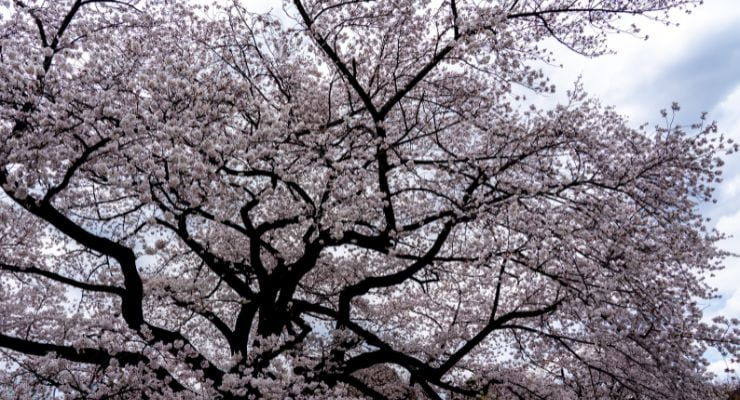
Acoma Crape Myrtle Tree (Lagerstroemia indica)
Acoma Crape Myrtle (Lagerstroemia indica x fauriei ‘Acoma’) is a deciduous tree that can reach a height of 7 feet and has drooping branches with abundant foliage and blooms. This tree is recognized for its ability to resist mildew, its appealing fall foliage, and its good capacity to tolerate drought. Acoma Crape Myrtle produces clusters of pure white flowers.
It is advisable to plant this tree in a sheltered location that is protected from winter winds, and mulch around the base to safeguard the roots. To encourage a tree-like shape, only trim inner shoots that are sprouting and crossing branches.
Remember, Crape myrtle thrives in full sun and requires at least 6 hours of sunlight per day.
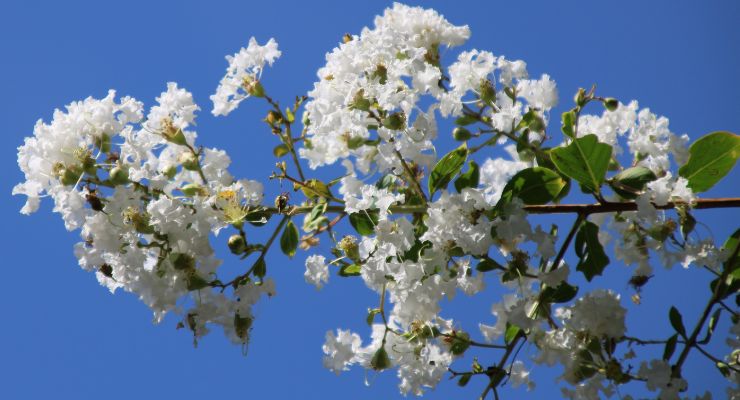
Carolina Silverbell (Halesia carolina)
Carolina silverbell (Halesia carolina) displays bell-shaped, white flowers that bloom in late April to early May. Carolina silverbells can grow up to 35 feet tall with a rounded, pyramidal, or vase-shaped habit.
It thrives in part shade and prefers moist, acidic, and organically rich soil. It’s essential to maintain consistently moist soil conditions and fertilize the tree in the spring with an acid-forming organic fertilizer to ensure its health and growth.
In dry environments, it may be necessary to install an irrigation system to keep the tree hydrated, particularly when it is young. However, once established, Carolina silverbell trees can withstand moderate drought.
Companion planting with azaleas and rhododendrons can offer extended visual interest as they typically bloom at different times.
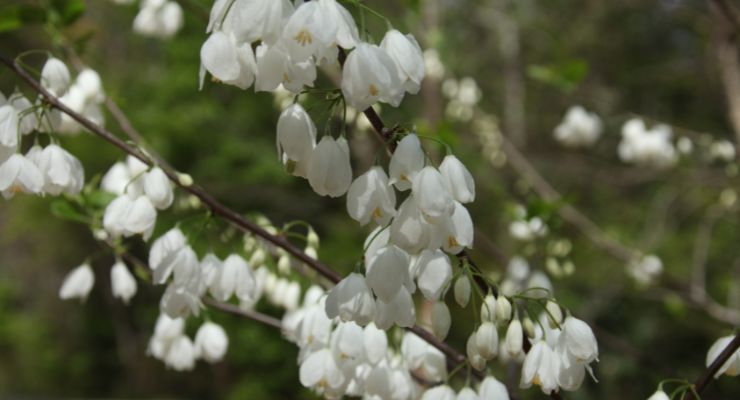
California Buckeye (Aesculus Californica)
A native of California and southwestern Oregon, the California buckeye (Aesculus Californica) is a broad-leaf tree with a flat-topped crown that can reach up to 20 feet in height. Its gray bark is often covered in lichens or mosses, and it is prized for its attractive white flowers and shiny, large leaves.
It’s important to note that the tree’s leaves are delicate and susceptible to damage from spring frost, snow, and summer heat and dryness. The California buckeye is deciduous in the summer and may lose its leaves in early July, making it the first tree to leaf out each year. It grows during the wet winter months and goes dormant during the dry summer months.
The California buckeye tree is highly toxic and can be deadly if consumed. The raw seeds are poisonous to humans, and the leaves and shoots are toxic to livestock.
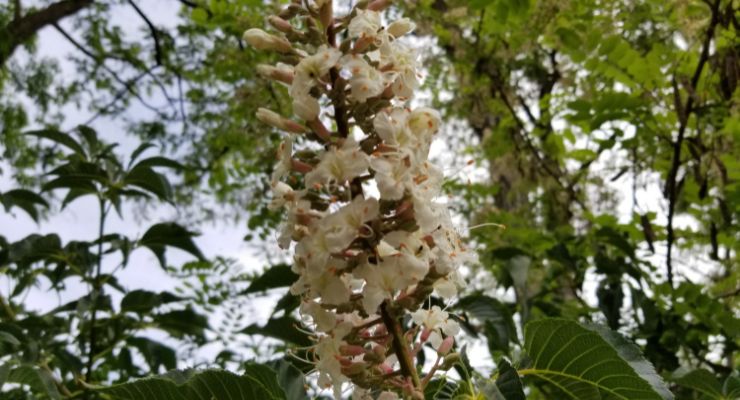
Limelight hydrangea tree (Hydrangea paniculata ‘Limelight’)
The Limelight Hydrangea Tree (Hydrangea paniculata ‘Limelight’) is a tree-shaped hydrangea that blooms with large, pale green flowers in the summer that gradually turn green and pink. This low-maintenance plant thrives in partially shaded areas with 4-6 hours of sunlight per day. It is a hardy and easy-to-grow tree, making it a popular choice among gardeners.
To maintain its elegant appearance, prune the tree annually during late winter or early spring before new growth appears. Trim back any growth on the main stem and clip branches down to about 2-3 sets of leaves. When making cuts, ensure that they are just above paired buds to allow them to develop into two new branches that grow opposite each other.
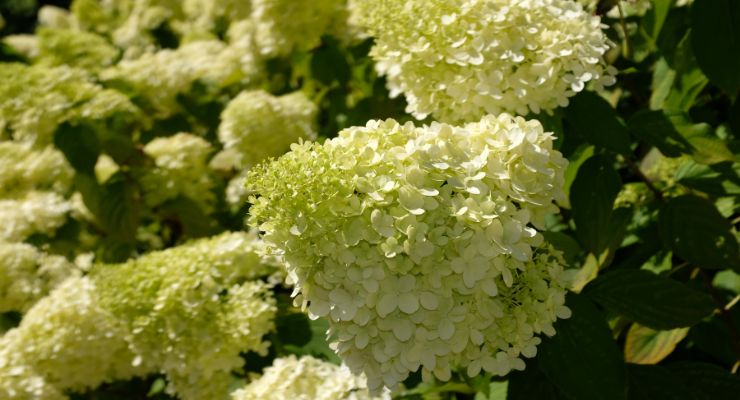
Japanese lilac tree (Syringa reticulata)
The Japanese tree lilac (Syringa reticulata) is a moderate-growing tree that can reach up to 30 feet tall and 20 feet wide, producing large clusters of small, fragrant creamy white flowers in early summer. To ensure optimal growth, it’s important to plant the tree in well-draining soil with full sun exposure. Late winter or early spring is the ideal time to plant a Japanese lilac tree, although late fall is also acceptable.
Water the tree according to its needs, either keeping the soil slightly moist or allowing the top inch or two to dry out before watering again. Lightly fertilize and prune occasionally to remove damaged twigs and stems.
Japanese lilac trees can be complemented with herbaceous peonies and tree peonies, which share similar color, fragrance, and form. Other suitable companion plants include mock orange, flowering crabapples, dogwoods, flowering cherries, magnolias, Iris, and Coneflowers.
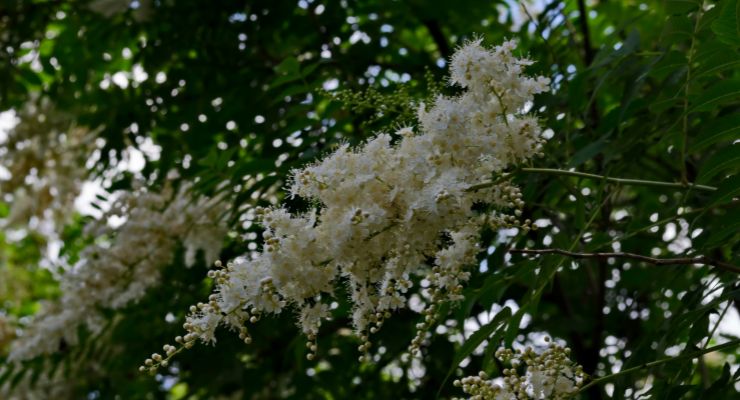
Giant dogwood (Cornus controversa)
Cornus controversa, also known as the giant dogwood, can be found in a medium sized tree to tall ornamental flowering tree that can grow up to 35-40 feet tall. It thrives in sun to partial shade and prefers moist, well-drained soil with a moderate growth rate. The tree boasts lovely delicate white flowers in the spring and gracefully layered branches with a wide, rounded form.
As the tree matures, it should only be pruned after flowering to avoid removing any of the current season’s white flowers. Pruning will be necessary to provide clearance beneath the canopy. The tree can be propagated by stem cuttings, grafting, or seed.
Regular watering and fertilization of the soil are recommended, and adding a layer of mulch can help retain moisture and prevent weed growth.
It produces attractive deep purple berries that appear from early to late fall and are popular among birds and small mammals.
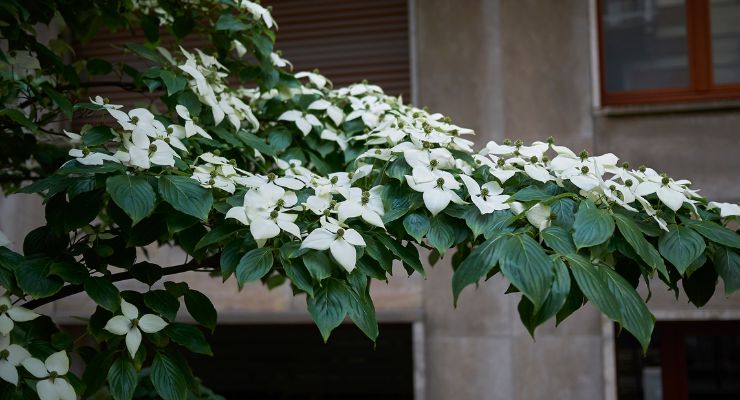
White Eastern Redbud (Cercis canadensis f. alba)
The white variety of the eastern redbud (Cercis canadensis f. alba) is a deciduous tree with a rounded crown that can reach a height of 20-30 feet when fully mature. It has a lovely flat-topped vase-shaped habit and bears masses of pure white pea-like flowers in clusters along the branches in early spring. The heart-shaped leaves emerge bronze, turn green, and then take on a yellow hue in autumn. As the state tree of Oklahoma, it is known for its moderate to rapid growth rate when young.
The tree prefers full sun to light shade and thrives in moist, well-drained soil that is deep. It can adapt to different soil types but does not do well in soil that is constantly wet or poorly drained. Due to its difficulty in transplanting, it is best to plant the tree when it is young.
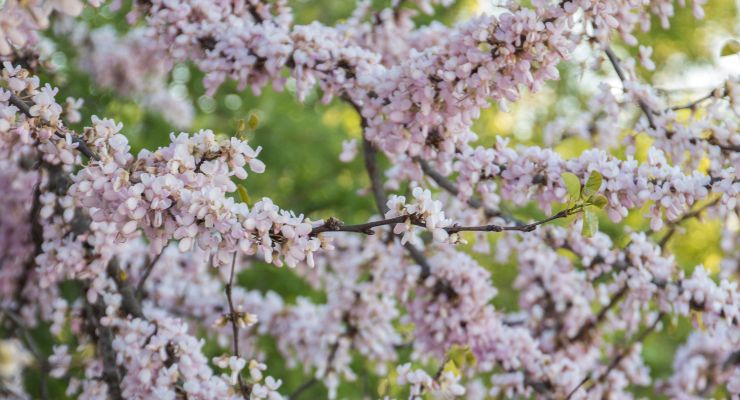
Hawthorn ‘Winter King’ (Crataegus viridis ‘Winter King’)
The Hawthorn tree, also known as Crataegus viridis ‘Winter King’, boasts silvery-green branches and a broad, spreading crown. With its multi-colored, flaky bark and persistent red fruits, it serves as an eye-catching specimen in any landscape. The ‘Winter King’ cultivar is especially popular due to its disease resistance, profuse spring bloom of white flowers, and larger fruit size.
This tree thrives in average, well-drained soils that range from dry to medium moisture levels and full sun exposure. While it can tolerate light shade and drought, excessively moist or fertile soil can lead to unwanted succulent growth. Minimal pruning is necessary for late winter or early spring to remove any damaged or misplaced growth, and gardeners should keep an eye out for caterpillars and gall
According to Celtic mythology, the Hawthorn tree symbolizes love and protection. It is also associated with Beltane, an ancient festival celebrating spring, and is believed to offer protection from storms and lightning. When hawthorn appears, it is thought to bring a message of hope and healing for the heart, both physically and emotionally.
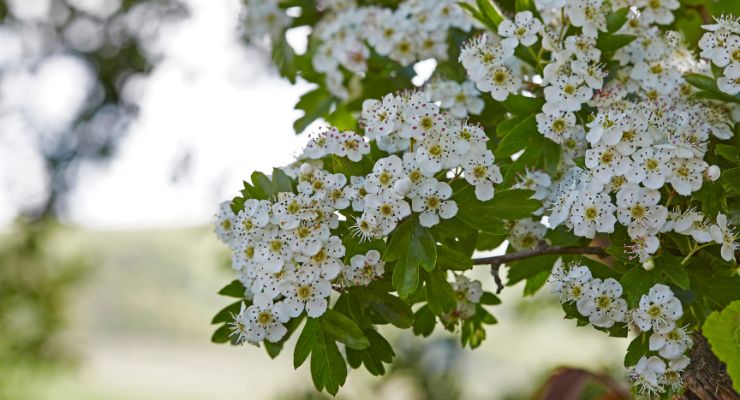
Conclusion
White flowering trees offer a unique and beautiful display for all seasons of the year. They can be used to add a touch of elegance to any backyard or garden, or as part of an outdoor event.
Choosing the right trees with showy white flowers depends on the local climate and soil conditions, as well as individual preferences. The best part is, white flowering trees are generally easy to care for and hardy in most climates.
Consider planting a few different varieties to ensure you have blooms year-round. With proper care, white flowering trees will provide beauty to your landscape for years to come.
They clean and filter air and also reduce noise pollution while increasing property values, making them an attractive choice for homeowners. They can also provide much-needed shade and food for wildlife.
In conclusion, white flowering trees can be a great addition to any garden or outdoor space. They add beauty and charm to the area, and with so many varieties available, it’s possible to find one that is perfect for your needs.
Not only do they provide lovely blossoms throughout the spring and summer months, but they also bring a certain feeling of serenity.
